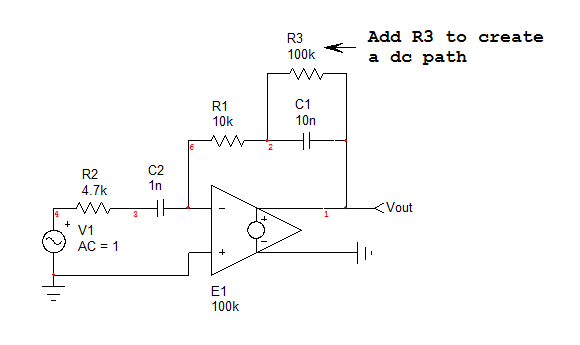The expression derived by LvW is correct but there are no steps showing how he got there. Of course, if you compute the gain \$H(s)=-\frac{Z_1(s)}{Z_2(s)}\$ in which \$Z_1(s)=R_1||\frac{1}{sC_1}\$ and \$Z_2(s)=R_2+\frac{1}{sC_2}\$ you'll get there but a) you can make mistakes while developing the expression b) you will need to rearrange the formula to unveil the needed gain in the flat portion. I will show how the fast analytical techniques or FACTs (see my book on the subject) will get you there just by inspecting simple schematics, no algebra at all. Look at the below schematic:

You start by determining the transfer function in dc, for \$s=0\$ and you do that by opening all caps. You find \$H_0=0\$ because the first cap blocks the dc and creates a zero at the origin. Then, you reduce the excitation to 0 V and "look" at the resistance offered by the capacitor connection terminals when they are temporarily removed from the circuit. Associating the resistance with the involved capacitor gives you the corresponding time constants. Considering the virtual ground, it is easy to find \$\tau_1=R_1C_1\$ and \$\tau_2=R_2C_2\$. You can sum these two guys to form \$b_1\$ in the denominator. \$b_2\$ is is simply obtained by combining \$\tau_1\$ with a time constant obtained when \$C_1\$ is replaced by a short circuit: \$\tau_{12}=C_2R_2\$: \$b_2=\tau_1\tau_{12}=R_1C_1R_2C_2\$. There is redundancy meaning \$b_2=\tau_2\tau_{21}\$ in which you combine \$\tau_2\$ with a time constant obtained when \$C_2\$ is replaced by a short circuit. Results are identical. The denominator equals:
\$D(s)=1+sb_1+s^2b_2=1+s^2(R_1C_1+R_2C_2)+s^2R_1C_1R_2C_2\$.
From this second-order polynomial form, we can define a quality coefficient \$Q=\frac{\sqrt{b_2}}{b_1}\$ and a resonant frequency \$\omega_0=\frac{1}{\sqrt{b_2}}\$.
The numerator can be derived using the generalized transfer function form obtained by calculating three gains when each capacitor is alternatively set in its high-frequency state (a short circuit) and when both caps are replaced by a short circuit. You can see from the sketches that a gain \$H_2\$ exists only when \$C_2\$ is replaced by a short circuit. The gain in this case is \$H^2=-\frac{R_1}{R_2}\$. The numerator is defined as:
\$N(s)=H_0+s(H^1\tau_1+H^2\tau_2)+s^2H^{12}\tau_1\tau_{12}=-sR_1C_2=-\frac{s}{\omega_z}\$ where \$\omega_z=\frac{1}{R_1C_2}\$.
With a proper factorization, you can rework this transfer function in a low-entropy form in which you immediately see the gain you wanted:
\$H(s)=-H_{bp}\frac{1}{1+Q(\frac{s}{\omega_0}+\frac{\omega_0}{s})}\$ in which the bandpass gain is simply \$H_{bp}=\frac{R_1C_2}{R_1C_1+R_2C_2}\$. With the given values, that bandpass gain is exactly 1.9988 or 6.015 dB. All calculations appear in the below Mathcad screenshots:


You can apply the FACTs to passive or active circuits. The nice thing is that you individually determine the coefficients of the numerator and the denominator via small sketches. That way, if a deviation exists between the raw formula and what you have derived, it is easy to solve the guilty intermediate step and correct it. With a brute-force analysis, you would have to restart from scratch. An introduction to the FACTs can be found here. I encourage students and engineers to acquire that skill given the ease and speed it provides when analysing transfer functions.
Addition to the original answer following a suggestion from G36:
A question was raised by G36 in the comments section on how to apply the FACTs in case \$C_1\$ was in series with \$R_1\$ rather than in parallel as in the original question? If you try to apply the FACTs and determine the time constants of this new circuit, you will find infinite values for \$\tau_1\$ and \$\tau_2\$ because there is no dc path when both capacitors are removed from the circuit (and \$V_{in}\$ reduced to 0 V). This is an indeterminacy and it must be removed. The simplest trick consists of adding a dummy resistance \$R_3\$ in parallel with \$C_1\$ and update the circuit as below:

The new picture to determine the time constants is shown below and you can see that the dc path created by the addition of \$R_3\$ helps us getting rid of the two indeterminacies:

You can now nicely determine all the time constants including \$R_3\$ and follow the path given in the original reply. If everything goes well, you should be find:
\$H(s)=-\frac{sC_2(R_1+R_3)+s^2R_1R_3C_1C_2}{1+s(R_3C_1+R_2C_2)+s^2R_3R_2C_1C_2}\$
Now factor \$R_3\$ in the numerator and the denominator then simplify:
\$H(s)=-\frac{sC_2(\frac{R_1}{R_3}+1)+s^2R_1C_1C_2}{\frac{1}{R_3}+s(C_1+\frac{R_2C_2}{R_3})+s^2R_2C_1C_2}\$
Now, when \$R_3\$ approaches infinity, this expression becomes:
\$H(s)=-H_{LF}\frac{1+\frac{s}{\omega_z}}{1+\frac{s}{\omega_p}}\$
with \$H_{LF}=\frac{C_2}{C_1}\$, \$\omega_z=\frac{1}{R_1C_1}\$ and \$\omega_p=\frac{1}{R_2C_2}\$.
The below Mathcad pictures confirm these calculations. First, \$R_3=100\;k\Omega\$:

It clearly confirms the gain equal to 0 in dc:

When \$R_3\$ is now pushed to infinity, the dynamic response turns into the response of a zero and a pole while the zero at the origin has disappeared:

Which clearly isn't true as if you dc-bias this circuit (without \$R_3\$), you should get 0 V in the output. Considering the absence of dc path in this case, I am not sure if this circuit has any physical sense or application as such?










